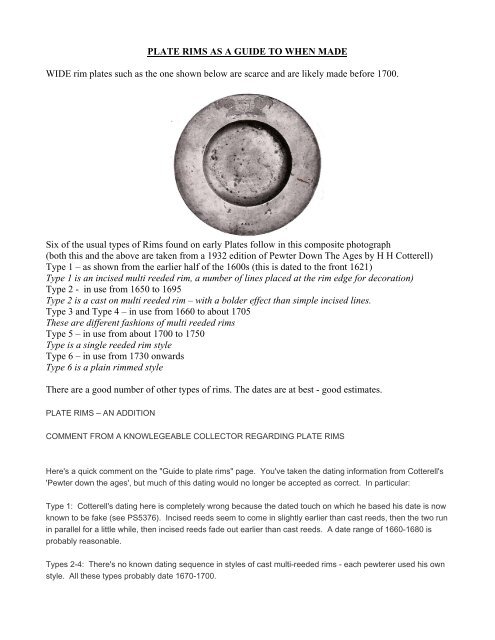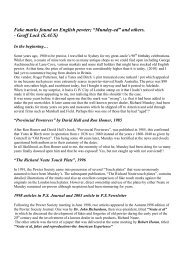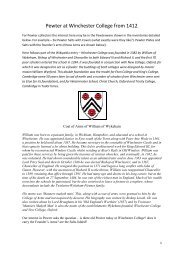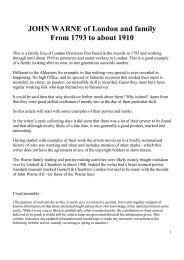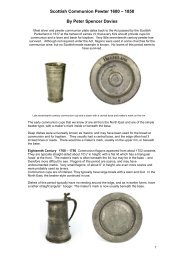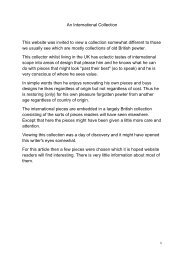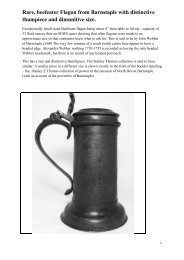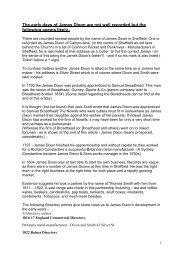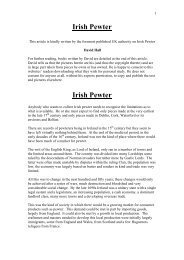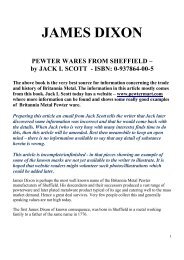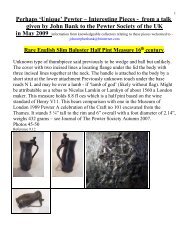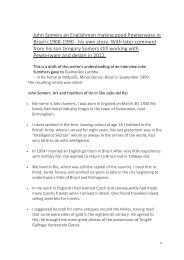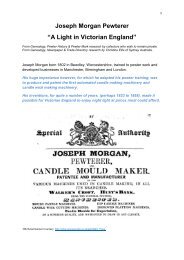2 PDF - PewterBank
2 PDF - PewterBank
2 PDF - PewterBank
Create successful ePaper yourself
Turn your PDF publications into a flip-book with our unique Google optimized e-Paper software.
PLATE RIMS AS A GUIDE TO WHEN MADE<br />
WIDE rim plates such as the one shown below are scarce and are likely made before 1700.<br />
Six of the usual types of Rims found on early Plates follow in this composite photograph<br />
(both this and the above are taken from a 1932 edition of Pewter Down The Ages by H H Cotterell)<br />
Type 1 – as shown from the earlier half of the 1600s (this is dated to the front 1621)<br />
Type 1 is an incised multi reeded rim, a number of lines placed at the rim edge for decoration)<br />
Type 2 - in use from 1650 to 1695<br />
Type 2 is a cast on multi reeded rim – with a bolder effect than simple incised lines.<br />
Type 3 and Type 4 – in use from 1660 to about 1705<br />
These are different fashions of multi reeded rims<br />
Type 5 – in use from about 1700 to 1750<br />
Type is a single reeded rim style<br />
Type 6 – in use from 1730 onwards<br />
Type 6 is a plain rimmed style<br />
There are a good number of other types of rims. The dates are at best - good estimates.<br />
PLATE RIMS – AN ADDITION<br />
COMMENT FROM A KNOWLEGEABLE COLLECTOR REGARDING PLATE RIMS<br />
Here's a quick comment on the "Guide to plate rims" page. You've taken the dating information from Cotterell's<br />
'Pewter down the ages', but much of this dating would no longer be accepted as correct. In particular:<br />
Type 1: Cotterell's dating here is completely wrong because the dated touch on which he based his date is now<br />
known to be fake (see PS5376). Incised reeds seem to come in slightly earlier than cast reeds, then the two run<br />
in parallel for a little while, then incised reeds fade out earlier than cast reeds. A date range of 1660-1680 is<br />
probably reasonable.<br />
Types 2-4: There's no known dating sequence in styles of cast multi-reeded rims - each pewterer used his own<br />
style. All these types probably date 1670-1700.
Type 5: Single reeds probably start a little before 1700 - perhaps 1690. London pewterers stopped making<br />
them for the London market around 1720. However, they were still making them for the American market until at<br />
least 1800. Similarly, the Bristol pewterers (who were major exporters to America) never stopped making single<br />
reeds - they too went on to at least 1800. Thus lots of single reed plates are a lot later than 1720.<br />
Type 6: Plain rims came in just before 1700. We know this because a pewterer who died in 1699 made them<br />
(though I forget who it was). They were still being made in 1820 (eg for the George IV coronation set).


